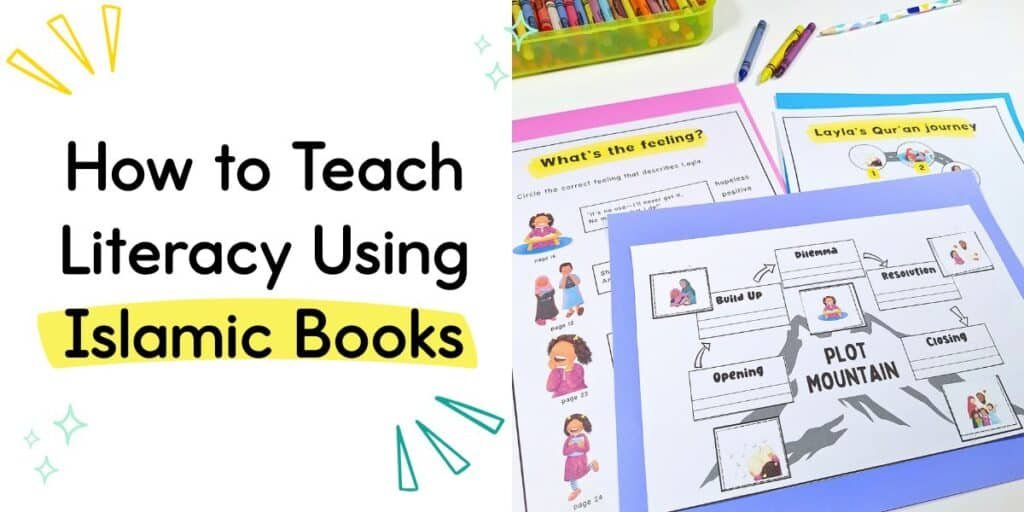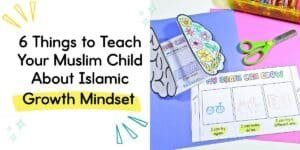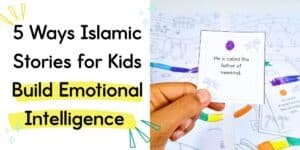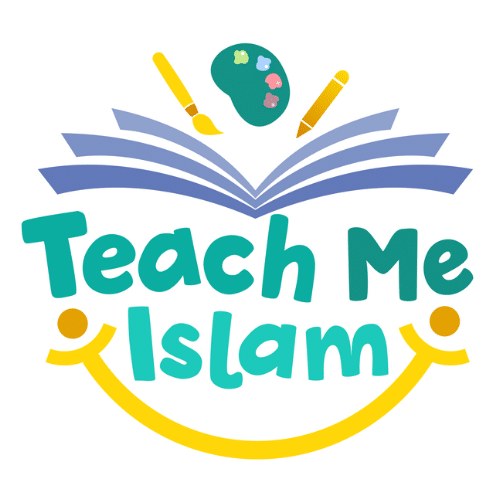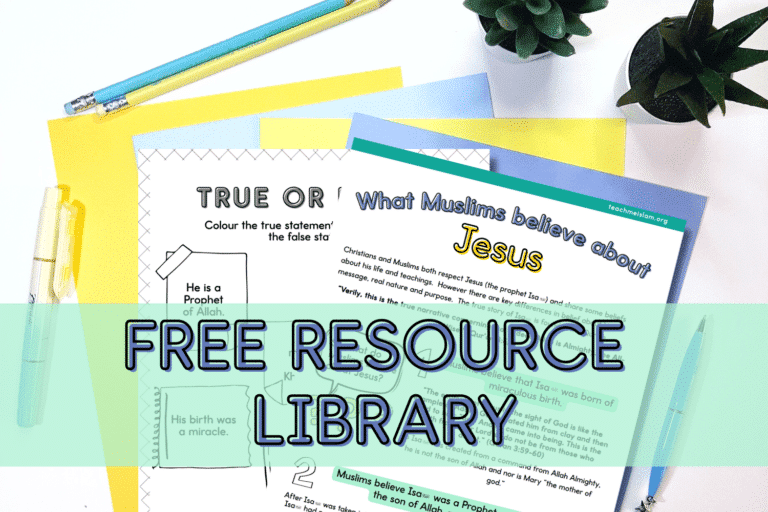Islamic books are a beautiful addition to your home library.
They help connect the joy of reading and storytime with Islamic concepts, values, and identity. They also help children process their own experiences—and feel seen—through the stories of Muslim characters.
But here’s the issue:
Most of these books don’t make it into literacy lessons. Not because they’re unworthy (though quality varies, like in all books)—but because resources don’t exist for them.
So children end up studying books that feel irrelevant—or worse, misaligned with their values.
And while many parents and teachers want to use Islamic stories, they often feel overwhelmed by the idea of planning lessons from scratch.
This post breaks down exactly what your children need to learn in literacy—and how you can teach it using almost any Islamic book.
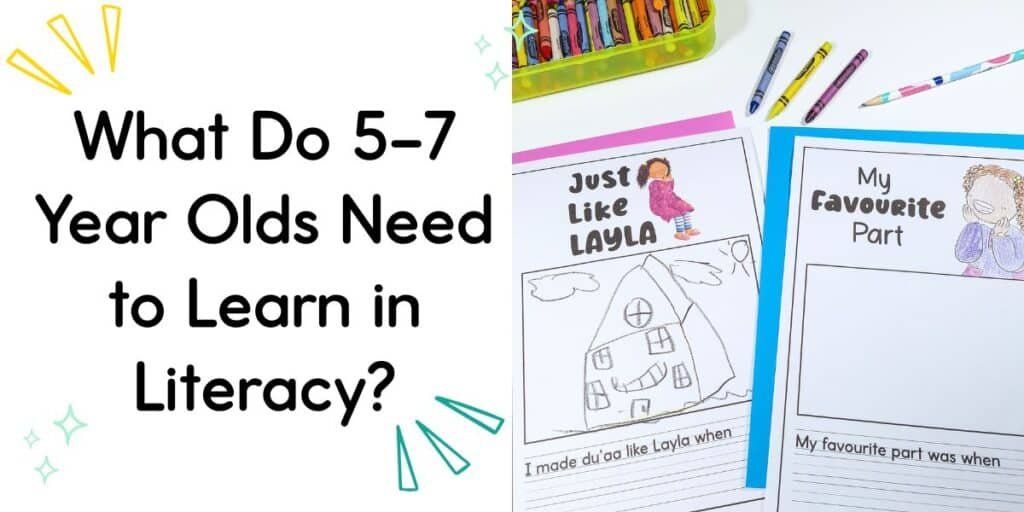
What Do 5–7 Year Olds Need to Learn in Literacy?
If you’re wondering what literacy actually involves (beyond decoding and reading words), the answer is: it’s all published for you.
Below are examples from two widely used systems:
🇬🇧 UK National Curriculum (Key Stage 1 – Years 1–2)
Reading – Comprehension:
- “Discuss the significance of the title and events”
- “Make inferences on the basis of what is being said and done”
- “Predict what might happen based on what has been read”
- “Link what they read to their own experiences”
Writing – Composition:
- “Write sentences by saying out loud what they are going to write”
- “Sequence sentences to form short narratives”
- “Re-read what they have written to check it makes sense”
👉 View the full Key Stage 1 English Curriculum here
🇺🇸 US Common Core Standards (Grade 1–2)
Reading Literature:
- RL.1.1 / 2.1: Ask and answer questions about key details
- RL.1.3 / 2.3: Describe characters, settings, and major events
- RL.1.7 / 2.7: Use illustrations and details to describe setting and plot
- RL.1.9 / 2.9: Compare and contrast experiences of characters
Writing:
- W.1.3 / 2.3: Write narratives recounting events in sequence
- W.1.8 / 2.8: Recall information from experiences to answer a question
👉 See the full US Common Core Standards here
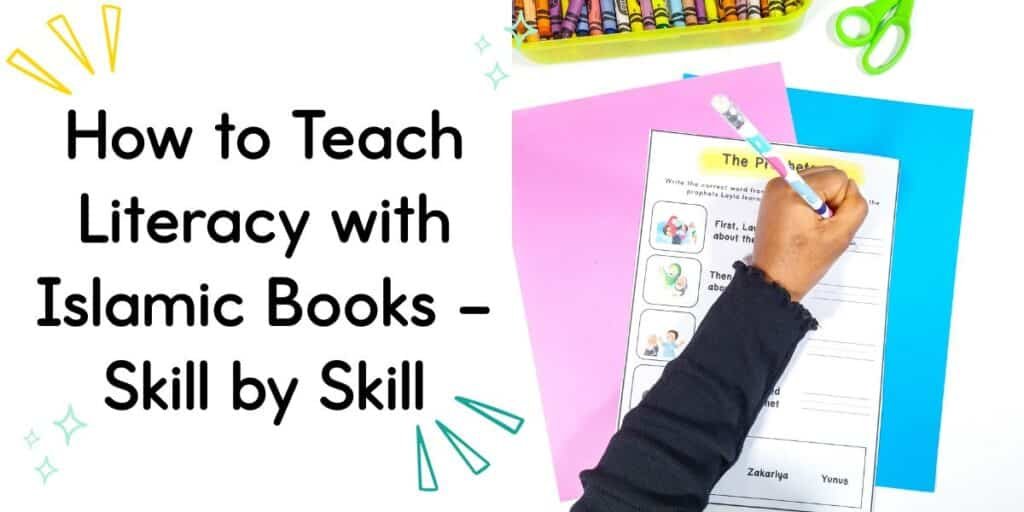
How to Teach Literacy with Islamic Books – Skill by Skill
Here’s how you can cover all these objectives using any well-written Islamic book.
📚 A. Understanding Book Structure
Objective: Identify the beginning, middle, and end of a story
UK: Retell familiar stories | US: RL.1.2
This might sound simple—but many children need help recognising story structure.
Model it:
“In the beginning, Layla’s mum comforted her… In the middle, she struggled… At the end, she succeeded.”
Activities:
- 🗻 Draw a story mountain together
- ✂️ Cut and sequence story events
- ✍️ Use sentence starters:
“First… Then… After that… Finally…”
🧠 B. Making Predictions
Objective: Predict based on title, cover, and events so far
UK: Predict what might happen | US: RL.1.1
Start every book unit with predictions—it gets kids thinking right away.
Ask:
- What kind of story is this—adventure? Mystery?
- Who do you think the main character is?
- What problem might they face?
Activities:
- 📖 Cover the last page and ask: “What do you think will happen?”
- 🗒 Use sticky notes for page-by-page predictions
- 🧠 Ask: “What would you do if you were this character?”
😌 C. Describing Characters & Feelings
Objective: Explain how characters feel and respond
UK: Inference | US: RL.1.3
This is where emotional intelligence grows. Stories give kids a safe space to explore feelings.
“Layla felt jealous when her brother was better at something. She felt frustrated, and wanted to give up.”
Activities:
- 🧍 Character maps: names, actions, feelings
- 🗣 Sentence frames like: “Layla felt _ because _.”
💭 D. Personal Connections
Objective: Relate the story to their own life
UK: Link to experiences | US: W.1.8
This is a life-long reading skill—taught early. All the way up to higher education personal response is important. It shows that students have really understood and engaged with the book and aren’t just parroting what their teachers have said.
Examples:
- “I’m determined like Layla because…”
- “I felt frustrated like her when…”
Activities:
- Fill in sentence starters
- Invite them to share a similar story
- Let them draw or write their own reflection
🔁 E. Retelling & Narrative Writing
Objective: Retell or write a story with sequence
UK: Sequence to form short narratives | US: W.1.3
Retelling helps children decide what’s important. For example in ‘The Three Little Pigs’ Goldilock’s dress colour is not an important detail—but that she entered the house without asking is.
Activities:
- 🗣 Oral retell using props or drawings
- 📖 Make a mini book:
First… Next… Then… Finally… - ✏️ Rewrite the ending or change a key detail
🖼 F. Using Illustrations
Objective: Use pictures to understand the story
UK: Discuss illustrations | US: RL.1.7
Young children rely on illustrations. They say a picture is worth a thousand words—because it really is.
Before they can infer from text, they learn to infer from pictures:
- A scared face
- Someone hiding
- A gloomy sky
Activities:
- 🔍 Picture detective: “What clues can you find?”
- 🗯 Match descriptions to illustrations
- 🎨 Ask: “What can we learn from this image?”
🧠 G. Vocabulary Building
Objective: Learn and use new words from the story
UK: Discuss new words | US: L.1.4
Reading aloud is one of the most powerful ways to grow vocabulary. Children are much more likely to remember a word if it helps them enjoy a story.
Tips:
- Choose 3–5 key words
- Pre-teach them with a quick picture or sentence
- Use them again during discussion or writing
Activities:
- 📌 Build a story word wall
- 🖼 Word + picture flashcards
- 🗣 Use new words in sentences straight away
Want All of This—But Don’t Have Time?
You can teach all of these skills using any Islamic book. But if you’d rather have everything planned for you…
🎉 Try our Layla Learns Qur’an Literacy Unit:
- ✅ UK & US curriculum-aligned
- ✅ Covers comprehension, writing, vocabulary, emotions & more
- ✅ Includes original artwork from the book
- ✅ Zero prep—just print and teach

